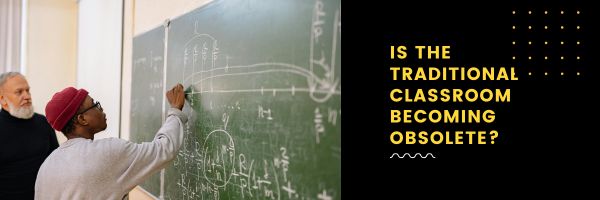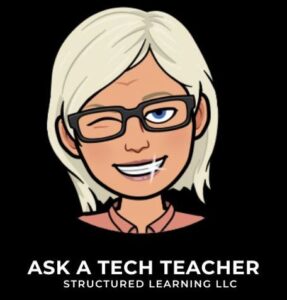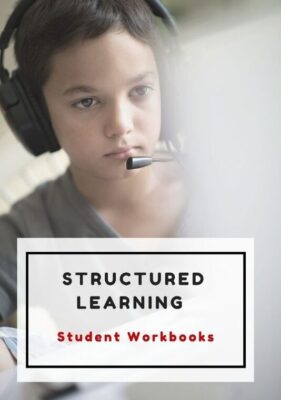Something broke in American education these past years. Too many students don’t reach grade-level metrics and no one can agree on the cause. I went out to our international contributors for ideas. They had a lot, but this one I thought I’d cover first:
Is the Traditional Classroom Becoming Obsolete?
You might argue that the traditional classroom still plays an essential role in education, but the rapid growth of online and hybrid models suggests otherwise. As students increasingly seek flexible and interactive learning experiences, the conventional approach may not meet their needs any longer. This shift raises critical questions about the future of education: How will teachers adapt their roles? What innovations might redefine the learning environment? Understanding these dynamics could reshape your perspective on what effective education looks like today.
The Rise of Online Learning
Online learning has increasingly become a staple in education, with studies showing that over 30% of students now prefer it over traditional classroom settings. This shift raises questions about the efficacy and long-term viability of conventional education methods. You might wonder why this preference exists. Data indicates that online learning offers flexibility that traditional classrooms often can’t match.
Students can learn at their own pace, tailoring the experience to their unique needs, which can enhance engagement and retention.
However, you should also consider the challenges that accompany this rise. Not all online platforms deliver quality education, and the lack of face-to-face interaction can hinder social development and collaborative skills. Reports highlight that many students struggle with self-discipline in an online environment, leading to higher dropout rates compared to traditional settings.
Moreover, issues like digital divide—where not all students have equal access to technology—raise concerns about equity in education.
Ultimately, while online learning’s popularity is undeniable, it’s essential to analyze its limitations and implications critically. As you explore this educational landscape, understanding both the advantages and drawbacks will be vital in determining the future of learning.
Benefits of Virtual Classrooms
As you consider the advantages of virtual classrooms, it becomes clear that they offer significant benefits that cater to modern learners.
To begin with, virtual classrooms provide unparalleled flexibility. A study from the U.S. Department of Education found that 77% of online students reported a better balance between their studies and personal life. This flexibility allows you to tailor your learning environment to your needs, increasing overall satisfaction and engagement.
Moreover, virtual classrooms often utilize a variety of technological tools that enhance interactivity and collaboration. Platforms like Zoom or Google Classroom enable real-time discussions, while forums foster ongoing dialogue beyond scheduled sessions.
Research indicates that active participation leads to higher retention rates, which can be upwards of 60% for students engaged in interactive learning.
Cost-effectiveness is another critical advantage. With virtual classrooms, you can save on commuting and accommodation expenses, which often accumulate in traditional settings.
According to a report from the Online Learning Consortium, institutions offering online courses can reduce operational costs by up to 50%.
Drawbacks of Remote Education
While virtual classrooms provide numerous advantages, they also present significant drawbacks that can impact the learning experience. One major issue is the lack of personal interaction. Studies show that students in remote settings often feel isolated, which can lead to decreased motivation and engagement.
Without face-to-face communication, building relationships with peers and instructors becomes challenging, hindering collaboration and support.
Another concern is the varying levels of access to technology. Not all students have reliable internet connections or devices, creating a digital divide that exacerbates existing inequalities—especially for younger learners in an online elementary school setting where consistent access is critical for foundational development.
This can result in some students falling behind due to circumstances beyond their control.
Additionally, remote education can lead to distractions in a home environment. Research indicates that students may struggle to maintain focus when surrounded by household responsibilities or entertainment options.
As a result, their academic performance may suffer.
Changing Student Expectations
Given the rapid evolution of technology and educational methods, student expectations have shifted considerably in recent years.
Today’s students demand more than just traditional lectures and textbooks; they’re looking for an engaging, flexible, and personalized learning experience. This change reflects both the advancements in technology and the increasing availability of information at their fingertips.
Here are three key expectations that are redefining modern education:
- Interactive Learning: Students expect dynamic, interactive lessons that incorporate multimedia elements and real-time feedback. Passive learning is no longer acceptable.
- Flexibility: Many students prefer a hybrid model that combines online and in-person education. They want the ability to learn at their own pace and choose when and where they study.
- Relevance to Real-World Applications: Students increasingly seek curricula that align with their career aspirations and life skills. They want to see how lessons apply to real-world scenarios rather than abstract theory.
These shifting expectations challenge traditional educational structures and demand that institutions adapt or risk becoming obsolete.
Meeting these needs is essential for fostering engagement and ensuring student success in today’s fast-paced world.
Teacher Roles in Modern Education
The role of teachers in modern education is evolving rapidly, necessitating a shift from traditional instructor-led models to more facilitative approaches. You’re no longer just a source of information; you’re a guide, helping students navigate an increasingly complex learning landscape.
Research indicates that students thrive in environments where teachers act as facilitators rather than mere dispensers of knowledge.
In this new paradigm, collaboration and critical thinking are essential. You’re expected to cultivate skills that prepare students for real-world challenges. Data shows that classrooms emphasizing inquiry-based learning see a notable increase in student engagement and retention.
As a result, your role involves creating a learning atmosphere that encourages questioning and exploration.
Additionally, the importance of emotional intelligence in teaching is gaining recognition. You’re tasked with understanding diverse student needs, fostering inclusivity, and addressing varying learning styles.
This approach not only enhances academic performance but also develops social-emotional skills vital for student success.
As you adapt to these expectations, consider how you can leverage your expertise to empower students. By embracing this multifaceted role, you’ll contribute greatly to shaping a generation of critical thinkers and problem solvers, ultimately redefining the educational landscape.
Technological Advancements in Learning
How have technological advancements reshaped the landscape of learning? You’ve likely noticed that tools like online platforms and interactive software have markedly altered how education is delivered. The integration of technology into learning environments is no longer optional; it’s essential.
Research shows that over 80% of students believe technology enhances their educational experience.
Consider these three ways technology is transforming learning:
- Accessibility: Digital resources allow you to access information anytime, anywhere, breaking geographical barriers that once limited education.
- Engagement: Interactive tools, such as gamified learning apps, make lessons more engaging, which can lead to better retention and understanding of complex subjects.
- Personalization: Adaptive learning technologies tailor educational experiences to your individual needs, allowing you to learn at your own pace and focus on areas that require improvement.
However, it’s important to acknowledge that while technology offers numerous benefits, it also presents challenges.
Issues like digital inequality and over-reliance on devices can hinder learning outcomes. As you navigate this evolving educational landscape, it’s essential to critically assess both the advantages and pitfalls of these technological advancements.
Hybrid Learning Models
What makes hybrid learning models an effective solution for today’s educational challenges? These models blend traditional face-to-face instruction with online learning, providing flexibility and catering to diverse learning preferences. According to a study by the Bill & Melinda Gates Foundation, hybrid learning can improve student performance by combining the best aspects of both environments.
In a hybrid model, you can engage with course materials at your own pace, allowing deeper comprehension. The use of digital tools fosters collaboration and interaction, which can enhance critical thinking skills. Additionally, research shows that students who participate in hybrid learning tend to retain information better, as they actively engage with content rather than passively receiving it.
However, it’s essential to address potential pitfalls. Not all hybrid models are created equal; ineffective implementation can lead to disengagement. A lack of training for educators in utilizing digital tools effectively can hinder the potential benefits.
Moreover, the reliance on technology necessitates robust infrastructure, which isn’t always present in all educational settings. To summarize, while hybrid learning models offer promising solutions, their success hinges on thoughtful execution and consistent evaluation.
Accessibility and Inclusivity
Hybrid learning models not only offer flexibility but also present unique opportunities for enhancing accessibility and inclusivity in education. By integrating technology with traditional methods, these models break down barriers that often hinder participation for diverse student populations.
Consider the following aspects that highlight the advantages of hybrid learning:
- Personalized Learning: With access to a variety of online resources, you can tailor your educational experience to meet your specific needs, accommodating different learning styles and paces.
- Reduced Physical Barriers: For students with disabilities, hybrid models can provide alternative formats for coursework and assessments, allowing greater participation without the constraints of physical classrooms.
- Geographical Reach: These models enable students from remote or underserved areas to access quality education and resources that might otherwise be unavailable in their local environments.
Data suggests that students in hybrid settings often report higher satisfaction levels due to these enhancements.
However, it’s essential to guarantee that technology is equitably distributed, so no one is left behind. As you navigate this evolving landscape, consider how these opportunities can foster a more inclusive educational experience for everyone.
Engagement in Traditional Classrooms
Engagement in traditional classrooms often hinges on the dynamic between students and educators. Research shows that when teachers employ interactive methods—like questioning techniques or group discussions—students are more likely to remain focused and invested in their learning.
However, many educators still rely heavily on lecture-based formats, which can lead to disengagement. According to a study by the National Center for Education Statistics, nearly 60% of students report feeling bored during class, a clear indication that the traditional model often fails to capture attention.
Moreover, traditional classrooms typically lack personalized learning opportunities. When educators don’t tailor their approaches to meet diverse learning styles, you may find yourself struggling to connect with the material.
Data reveals that differentiated instruction can increase student engagement by up to 30%. This suggests that the one-size-fits-all method prevalent in many traditional settings is ineffective.
While some teachers do succeed in fostering engagement, they’re often the exception rather than the rule. The reliance on outdated methods creates a significant barrier to meaningful learning experiences.
If we’re looking to enhance engagement, it’s essential to rethink how traditional classrooms operate.
Social Interaction and Learning
Social interaction plays an essential role in the learning process, especially in traditional classroom settings where collaboration can greatly enhance understanding. You might find that engaging with peers not only reinforces your knowledge but also develops critical thinking skills.
Studies indicate that students who collaborate in groups often achieve higher academic performance compared to those who study alone.
Here are three key benefits of social interaction in learning:
- Enhanced Communication Skills: Regular interaction with classmates helps you articulate your thoughts, ask questions, and express ideas clearly.
- Diverse Perspectives: Collaborating with peers exposes you to different viewpoints, enriching your understanding of complex topics and encouraging open-mindedness.
- Emotional Support: Social connections in the classroom provide a safety net, reducing anxiety and increasing motivation, which are essential for effective learning.
However, as educational models evolve, you need to assess whether the social interaction that thrives in traditional classrooms can be replicated in more digital learning environments.
If not, the absence of these interactions may hinder your learning experience, potentially leading to a generation of students lacking critical collaborative skills.
Future Classroom Innovations
The classroom of the future is poised to revolutionize education through technology and innovative teaching methods. You’ll witness a shift where traditional boundaries dissolve, allowing for personalized learning experiences tailored to individual needs.
Data from recent studies indicate that adaptive learning technologies can markedly enhance student engagement and performance by providing real-time feedback and customized content.
Virtual and augmented reality are set to transform how you explore complex subjects. Imagine immersing yourself in historical events or conducting virtual science experiments, making learning both interactive and impactful.
Additionally, artificial intelligence will play a vital role in automating administrative tasks, freeing educators to focus more on teaching and mentoring.
Collaborative platforms will also redefine teamwork, enabling you and your peers to work together seamlessly, regardless of physical location. This kind of connectivity prepares you for an increasingly global workforce.
Moreover, gamification elements in educational content will drive motivation, encouraging you to tackle challenges with enthusiasm.
As these innovations emerge, they’ll necessitate a reevaluation of curricula and teaching strategies, ensuring they’re relevant in a rapidly changing world.
The future classroom isn’t just a vision; it’s an impending reality, ready to reshape the educational landscape.
Cost Implications of Education
As educational innovations advance, understanding the cost implications becomes essential for institutions and students alike. The shift from traditional classrooms to more innovative models raises several financial considerations that can greatly impact both parties.
You need to analyze these implications critically to make informed decisions about the future of education.
- Technology Investment: Schools must invest in technology like interactive whiteboards, tablets, and online platforms. These upfront costs can strain budgets, but they’re essential for modern learning environments.
- Teacher Training: Educators require training to effectively use new tools and methods. This ongoing professional development can add to operational costs, yet it’s fundamental for maximizing the benefits of innovative teaching strategies.
- Access and Equity: As more learning moves online, disparities in access to technology can exacerbate educational inequalities. Institutions must consider how to provide resources for all students, often requiring additional funding.
Global Perspectives on Education
Education’s landscape varies dramatically across the globe, reflecting diverse cultural, economic, and political contexts. In Finland, for example, a strong emphasis on equity and teacher autonomy fosters an environment where students thrive, leading to some of the highest academic outcomes worldwide.
Conversely, in regions like sub-Saharan Africa, systemic issues such as inadequate funding and infrastructure hinder educational access, with UNESCO reporting that over 260 million children remain out of school.
You can’t ignore the impact of globalization either. Countries increasingly adopt international benchmarks, pushing for standardized curricula that often prioritize STEM over the arts. While this can enhance competitiveness, it risks homogenizing educational experiences and neglecting local cultural values.
Additionally, the COVID-19 pandemic exposed significant disparities in technology access, revealing that students in lower-income nations faced steep barriers to remote learning.
As you assess these global perspectives, consider how they shape your understanding of the traditional classroom’s relevance. Are we moving toward a one-size-fits-all approach, or can we learn from these diverse systems to create a more inclusive and effective educational framework?
The answers lie in careful analysis and open dialogue across borders.
Conclusion
As education evolves, the question remains: can traditional classrooms truly compete with the dynamic, flexible models emerging today? While face-to-face interaction still holds value, the data shows that online and hybrid learning greatly enhance engagement and accessibility. With students demanding more interactive experiences, it’s vital for educational institutions to rethink their approaches. Embracing innovation isn’t just beneficial; it’s essential for meeting the needs of a diverse student body in an increasingly digital world.
Photo Source: https://www.pexels.com/photo/student-answering-the-questions-on-a-black-board-8197540/
Here’s the sign-up link if the image above doesn’t work:
“The content presented in this blog are the result of creative imagination and not intended for use, reproduction, or incorporation into any artificial intelligence training or machine learning systems without prior written consent from the author.”
Jacqui Murray has been teaching K-18 technology for 30 years. She is the editor/author of over a hundred tech ed resources including a K-12 technology curriculum, K-8 keyboard curriculum, K-8 Digital Citizenship curriculum. She is an adjunct professor in tech ed, Master Teacher, freelance journalist on tech ed topics, and author of the tech thrillers, To Hunt a Sub and Twenty-four Days. You can find her resources at Structured Learning.







































It was an interesting overview of the advantages and disadvantages of online learning and the way education is evolving. It seems to be like a hybrid model might be a good way to go. Having both social interaction and personal guidance, as well as the efficiency (and commute savings) of online learning. International standards seems to be more widespread like you say. On a personal note, I am learning French, just as a hobby, and there’s a DELF standard for languages where you achieve skill levels A1, A2, B1, B2, C1, etc.
Education is definitely changing. American standards don’t seem to be keeping up with international. This is a good alternative possibly. Thanks for commenting, Thomas.